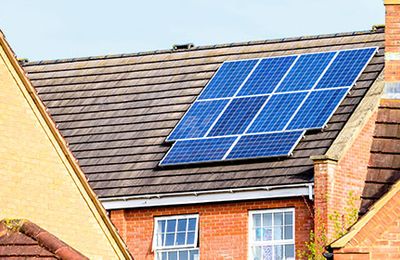What is the Smart Export Guarantee?
The Smart Export Guarantee is designed to make payments to customers for any renewable energy they have produced from their homes that they are not using themselves and is put back into the national grid. It was introduced to replace the Feed-in Tariff (FIT) scheme, which pays a large number of solar panel owners for the electricity they generate. Large energy suppliers have needed to participate in the SEG since the start of 2020. The electricity can be produced by any of the renewable technologies below:
- Solar panels (PV)
- Wind
- Hydro
- Micro combined heat and power
- Anaerobic digestion
The government has stated that homes providing excess renewable energy into the grid are guaranteed to be paid for it under the SEG. However, customers will be required to sign up for a SEG tariff with a company, otherwise, you will not be paid for your electricity and anything that you produce and don’t use will be exported to the National Grid for free.
How much could you earn through SEG with solar panels?
Adding renewable energy technology to your home and signing up for a SEG tariff will allow you to use more renewable electricity and should help you save money on your bills long term. However, it is not likely that you will be able to earn as much money from the SEG as some solar panel owners could initially get from the FIT. This is because the Smart Export Guarantee will only pay for any excess electricity that is sent back to the grid, rather than all of the electricity that is produced from your solar panels.
Different energy companies can set their own SEG tariff prices, so you will need to do your research to ensure you get the best price for you and your circumstances. Suppliers are required to pay more than zero, but there can be significant variations between the best and worst rates. When widely available tariffs were checked at the end of 2020, it was found that companies were usually paying between 1p/kWh and 5.5p/kWh (or even as much as 11p/kWh if you chose a tariff that needed you to have a specific battery). This means there could be more than a 5-fold difference in your payments, which would quickly add up over the course of a year if you are exporting a lot of electricity to the grid.
The highest SEG rate was £82.5, and the lowest rate was £15 based on export tariffs available in November 2020 that don’t need a specific battery. These figures are simply for illustration based on a 4kWp system that is exporting 1,975kWh of electricity back to the grid in a year. To put this into context, the standard medium household uses 2,900kWh of electricity over a year.
Additionally, you can expect to save money on your bills as you would be using renewable energy produced at home, meaning you are not buying your energy from the grid. You might even be able to save more from needing to buy less from the grid than you could make from exporting excess electricity that you generate. The amount you could save and your SEG earnings will depend on:
- How much electricity you are exporting to the grid
- Your export tariff rates
- The time of export (if the SEG has a time-variable rate)
- The amount of electricity generated you are using yourself
- The price you are paying for electricity
- How much time you spend at home, especially during the day
So, if you are thinking about installing renewable energy technology, be sure to take these factors into account against the cost of fitting your system (if you are not eligible for a solar panel grant) and the maintenance costs to calculate how long it will take the system to pay for itself.
If you have a home battery fitted, you can store and use more of the electricity you have produced, meaning you can save more on your bills. However, various tariffs will have different rules regarding whether they will pay for electricity stored in a battery, particularly if some of it could be ‘brown’ energy from the grid.
You should check what the rules are for your chosen SEG company. If they are willing to pay for stored electricity, then you could earn more with a flexible tariff by storing electricity to send back to the grid at times when the rates are higher. However, you will also need to consider the upfront cost of the battery itself.

Which suppliers have SEG tariffs?
Any suppliers that have over 150,000 customers are required to offer a SEG tariff. Small companies have the option to do so and some other companies that aren’t conventional energy suppliers have started offering tariffs to their customers as well (such as Tesla and Social Energy), so stay vigilant for the different options that could be available to you.
The largest energy companies across the UK all offer SEG tariffs. Other companies that have SEG customers include Avro Energy, Bulb, Green Network Energy, Octopus, OVO, Shell, and more. Companies with over 150,000 customers have to offer at least one SEG tariff that is export-only, which means payments are available for all eligible installations, not just those of their customers. Therefore, you can normally choose a different company to sell your renewable electricity to than the one you buy (or have bought) your electricity from.
However, some suppliers will pay for your electricity into your account with them if you are a customer already, which could be more convenient for you. Also, some tariffs might offer a better export rate if you purchase your energy from the same firm.
Types of SEG tariffs
We have seen two types of Smart Export Guarantee tariffs mentioned so far:
- Fixed rate- SEGs have a specific amount that they pay per kilowatt hour of electricity you provide to the grid, regardless of when you transfer it. The majority of the SEG tariffs that are available at the moment follow this model.
- Flexible rate- SEGs pay different amounts based on how valuable the electricity is to the system at different times. For instance, the rates might be related to day-ahead wholesale prices. So, you could receive more money for exporting your electricity at a time when there will be high demand for it (such as, in the evening when more people are at home). Octopus Energy’s Outgoing Agile tariff falls into this category.
Companies can also offer multi-rate SEGs where there are different set rates for electricity provided to the grid at different times, like day and night rates, or weekday and weekend rates. The amount you are paid for exporting your electricity must not be less than zero at any time.
To make the situation more complicated, some suppliers offer tariffs where the price (per kWh of electricity) is fixed for the duration of the contract, whilst others are offering variable rates. With a variable rate, they can charge the price of the tariff depending on whether they want to pay more or less for your energy. Although if this is the case, you should be given 30 days’ notice.
Can you get a SEG tariff?
If you get solar panels, a wind turbine, or other renewable technology installed at your home, you should be able to sign up for a SEG tariff. However, you will be required to meet specific criteria which include the following:
- Your installation needs to be 5MW or less in capacity (50kW for micro-CHP)
- You will need a meter that can provide half-hourly readings for exporting electricity
- Your installation has to be MCS-certified
Practically speaking, in order to provide half-hourly meter readings, it is quite likely that you will need a smart meter. Although the government stated that it is ‘still possible to enjoy the benefits of SEG without a smart meter’, you will require more than just a standard electricity meter because these are not able to take half-hourly readings. Certain advanced meters can do this or ‘any other type of export meter’, according to the government, but you will need to have one of these installed.
However, some customers have been refused smart meters because of their solar panels. So, it is important to ensure that you get a second-generation smart meter that can definitely take export meter readings if you are thinking about fitting a renewable source of energy.
MCS certification involves selecting a product and using an installer that are both approved by the microgeneration certification scheme (MCS). This scheme focuses on quality assurance for renewable technologies to make sure that companies and products installed meet the highest possible standards.
If you have fitted solar panels or a different type of renewable system since the FIT scheme closed, you should still be able to sign up with a company that is offering SEG payments as long as you fit the specified criteria. Keep in mind though that you won’t be allowed to claim back payments before you sign up to an SEG tariff.
